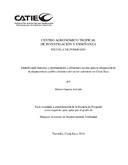| dc.contributor.author | Guerra Arévalo, Héctor | |
| dc.date.accessioned | 2015-07-13T20:59:00Z | |
| dc.date.available | 2015-07-13T20:59:00Z | |
| dc.date.issued | 2014 | |
| dc.identifier.uri | https://repositorio.catie.ac.cr/handle/11554/7080 | |
| dc.description | Tesis (Mag. Sc. en Socioeconomía Ambiental) -- CATIE. Escuela de Posgrado. Turrialba (Costa Rica), 2014 | es_ES |
| dc.description.abstract | El objetivo del presente estudio fue identificar las barreras y oportunidades a diferentes escalas para la integración de la adaptación al cambio climático del sector cafetalero de Los Santos, Costa Rica. Para esto se identificaron a los diferentes actores de interés (productores y organizaciones), y se aplicaron entrevistas semi-estructuradas orientadas a explorar cuatros aspectos fundamentales de este trabajo: i) percepción de los actores, i) identificación de las medidas de adaptación, iii) redes de apoyo y de información a través de las escalas y áreas políticas, y iv) barreras para la integración de la adaptación. Para el primer caso, el análisis de modelos mentales permitió conocer las percepciones sobre los impactos del cambio climático que afectan la actividad cafetalera. El análisis de efectividad y de relevancia permitió identificar a las medidas más importantes valoradas por los productores y por las organizaciones del sector. Para los flujos de apoyo y de información al interior de la red, se empleó el indicador de centralidad de los actores, además de la percepción de influencia y de competencia de los demás actores de la red. Finalmente, una serie de preguntas enmarcadas en diversos componentes permitió abordar las barreras para la integración de la adaptación al cambio climático. Los resultados muestran que la percepción de los actores sobre la afectación de los impactos del clima ha sido evidente en la zona de estudio y se percibe que lo seguirá siendo en el futuro. Las medidas de adaptación reflejaron una buena valoración por parte de los actores, aunque se resaltaron algunas barreras en la incorporación de medidas en sus labores y operaciones de los actores del sector a diferentes escalas. Relacionados con la redes de apoyo y de información también se identificaron barreras presentes en las áreas políticas y escalas consideradas. Finalmente, las barreras para la integración reflejaron profunda incertidumbre y ansiedad acerca del futuro del clima, del financiamiento, de la actividad cafetalera, y de los precios del café; además de la falta de recursos humanos y técnicos y financieros se mostraron como principal berrara para la integración de la adaptación. | es_ES |
| dc.description.abstract | The aim of this study was to identify barriers and opportunities at different scales for the integration of climate change adaptation in the coffee sector of Los Santos, Costa Rica. For this we identified the different actors of interest (producers and organizations), and semi - structured interviews designed to explore four fundamental aspects of this work were applied: i) perception of the actors, ii) identification of adaptation measures, iii) support networks and information across scales and policy areas, and iv) barriers to the integration of adaptation. For the first case, the analysis of mental models determines the perceptions of the impacts of climate change affecting the coffee industry. The analysis of effectiveness and relevance in identification of the most important measures valued by producers and industry organizations. For flows of support and information within the network, the indicator centrality of actors, plus the perception of influence and competence from other actors in the network are used. Finally, a series of questions framed in various components allowed addressing the barriers to the integration of climate change adaptation. The results show that the actors perceive the effect on climate impacts as evident in the study area and feel that it will continue in the future. Adaptation measures reflected a good assessment by the actors, although some barriers were highlighted in the incorporation of measures in their work and operations of the industry players. Their relations to support networks and information barriers were also identified at the
different scales considered. Finally, barriers to integration of adaptation are also reflected by their deep uncertainty and anxiety about the future of the climate, the financing of the coffee industry, and coffee prices, and the scarcity of human, technical and financial resources. | en_EN |
| dc.language.iso | es | es_ES |
| dc.publisher | CATIE, Turrialba (Costa Rica) | es_ES |
| dc.relation.ispartof | Programa Agroambiental Mesoamericano (MAP). Fase I | |
| dc.subject | ACTIVIDAD CAFETALERA | es_ES |
| dc.subject | SECTOR CAFETALERO | es_ES |
| dc.subject | ADAPTACION | es_ES |
| dc.subject | CAMBIO CLIMATICO | es_ES |
| dc.subject | IMPACTO | es_ES |
| dc.subject | MEDIDAS DE ADAPTACION | es_ES |
| dc.subject | PRODUCTORES | es_ES |
| dc.subject | ORGANIZACIONES | es_ES |
| dc.subject | INTERACCION | es_ES |
| dc.subject | LOS SANTOS | es_ES |
| dc.subject | COSTA RICA | es_ES |
| dc.title | Identificando barreras y oportunidades a diferentes escalas para la integración de la adaptación al cambio climático del sector cafetalero en Costa Rica | es_ES |
| dc.type | Tesis de maestría | es_ES |
| dcterms.rights | acceso abierto | es_ES |
| dc.identifier.publisher | CATIE | es_ES |
| dc.identifier.publication | CATIE | es_ES |


